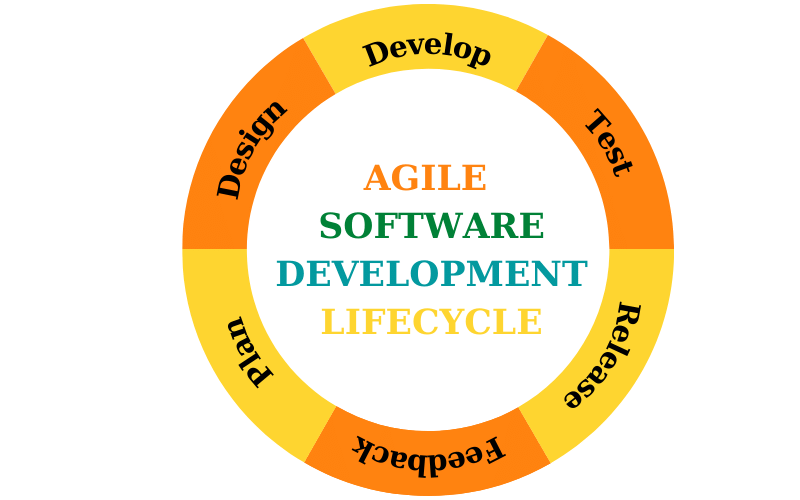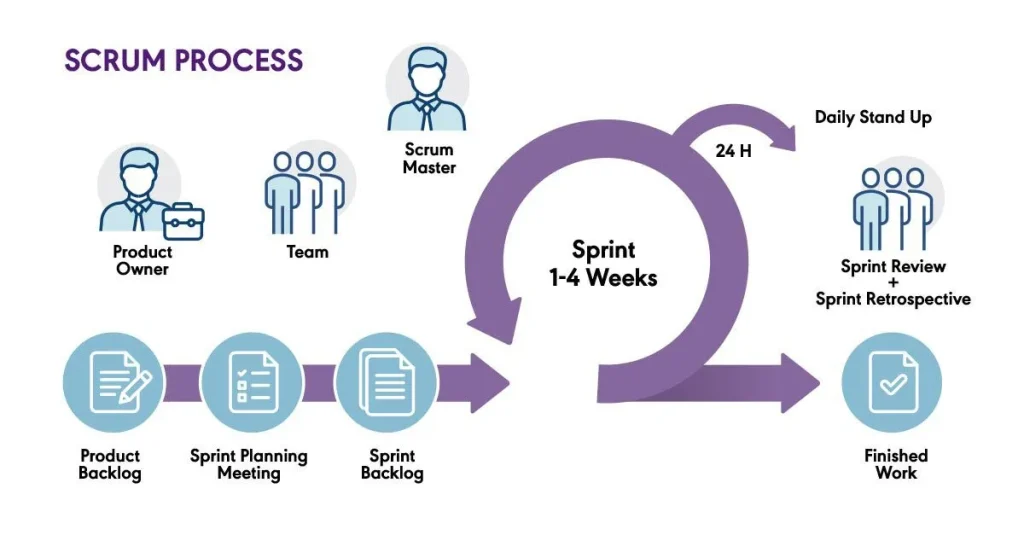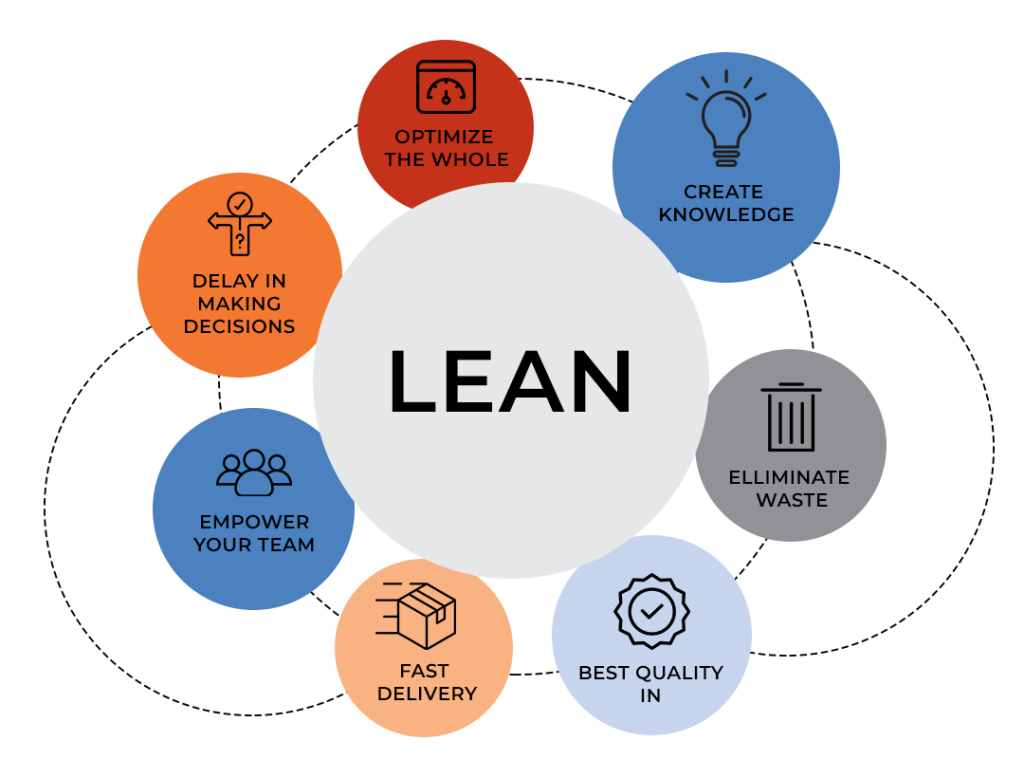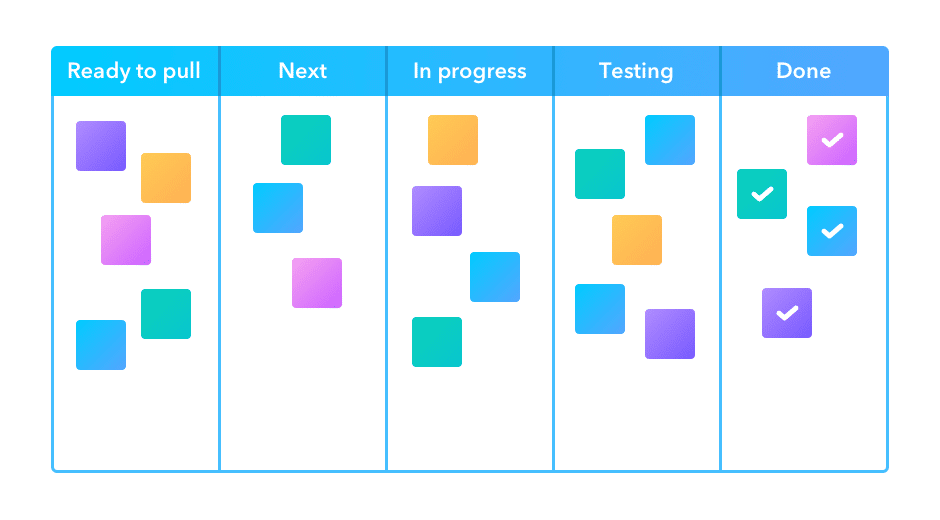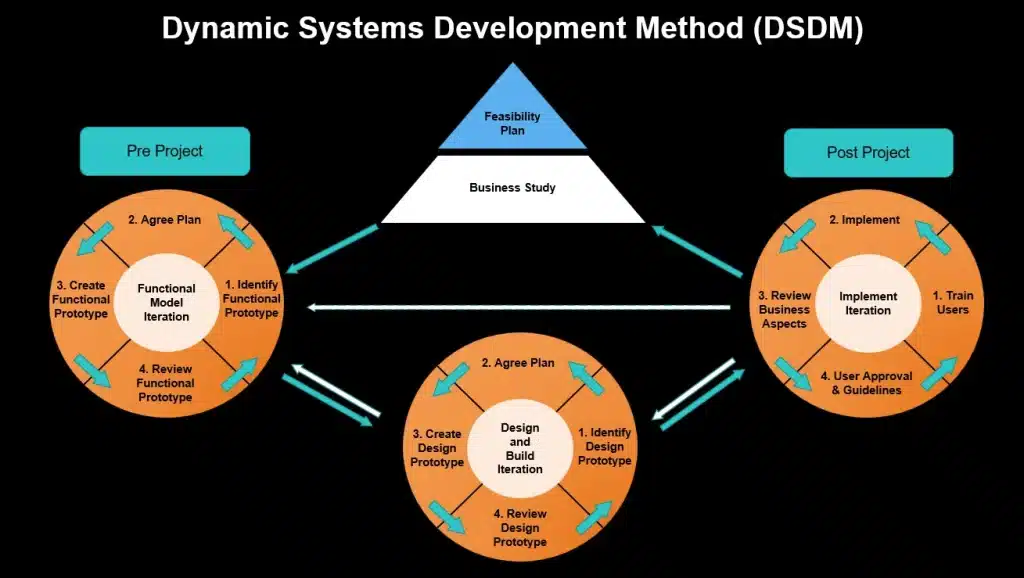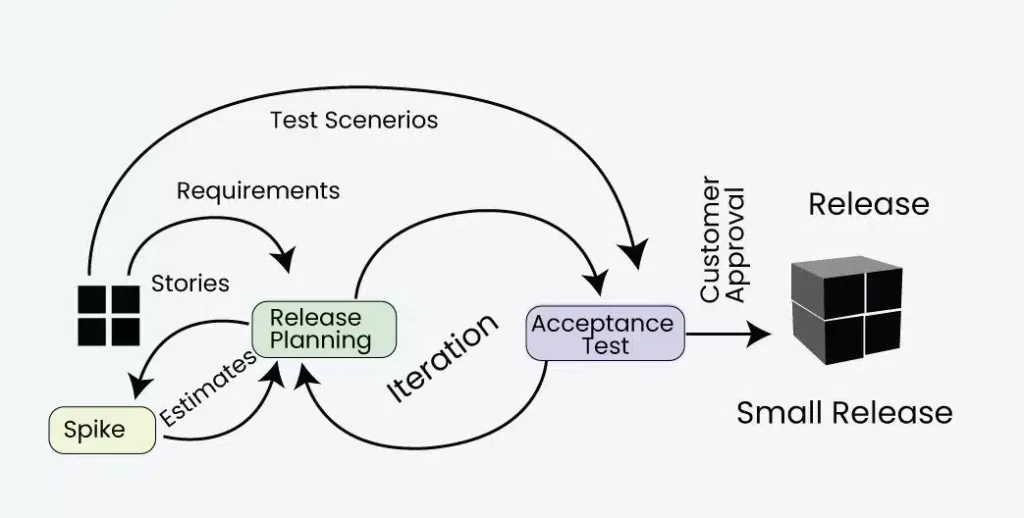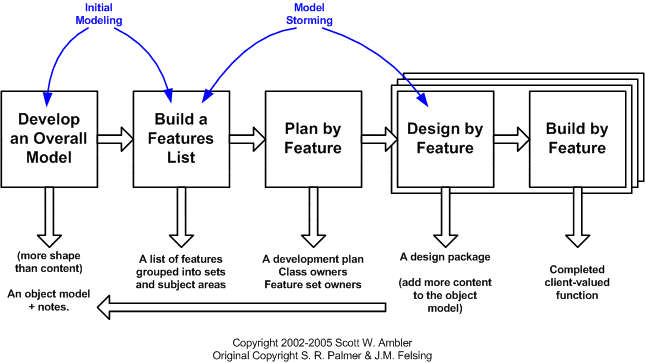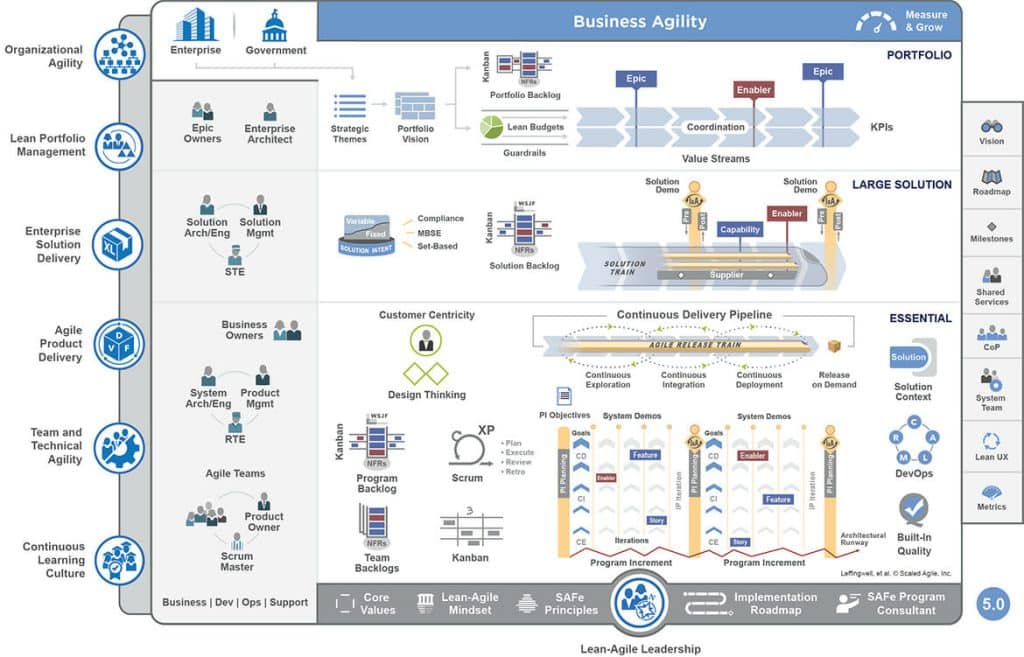Agile methodology: Definition, Phases and Types
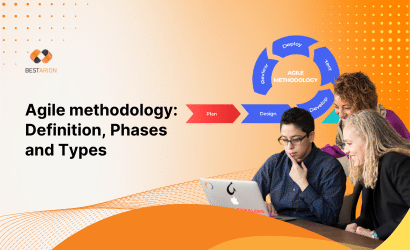

What is Agile Methodology?
Agile methodology is a flexible and iterative approach to software development that focuses on delivering high-quality products through continuous planning, collaboration, and customer feedback. It transforms ideas and requirements into working software by breaking the development process into smaller, manageable units known as iterations or sprints.
At the core of Agile is a commitment to responding to change, engaging stakeholders, and delivering value early and often. The process begins with customers clearly defining the product’s goals and the problems it aims to solve. This early engagement helps development teams fully understand and align with customer expectations.
Agile teams then plan, develop, test, and review in short cycles, allowing for regular feedback and continuous improvement. Because the process is incremental, teams can quickly identify and fix errors during development—rather than waiting until the end of the project. This results in a final product that is more closely aligned with user needs and business goals.
Agile’s team-based model supports adaptability, encourages cross-functional collaboration, and promotes fast delivery of usable software, making it a preferred methodology for dynamic, fast-paced projects.
The foundation of Agile lies in the Agile Manifesto, which outlines four core values:
-
Individuals and interactions over processes and tools
-
Working software over comprehensive documentation
-
Customer collaboration over contract negotiation
-
Responding to change over following a plan
These values are supported by 12 guiding principles that promote continuous delivery, stakeholder engagement, and adaptability.
Agile Software Development Lifecycle (SDLC)
What is Agile Software Development Lifecycle (SDLC)?
The Agile Software Development Lifecycle (SDLC) is a structured yet flexible framework that guides the development of software products using Agile principles. Unlike traditional models (like the Waterfall model), the Agile SDLC emphasizes iterative development, continuous feedback, and customer collaboration, enabling teams to deliver high-quality software faster and more efficiently.
Key Phases of the Agile SDLC
The Agile SDLC typically consists of six to eight iterative stages, often referred to as sprints. Here’s a breakdown of each phase:
1. Concept Phase
The Agile process starts by defining the project scope and identifying the most valuable business opportunities. In this phase, product owners, stakeholders, and development teams come together to:
-
Brainstorm potential projects and product ideas
-
Estimate the cost, time, and resources needed for each project
-
Prioritize the product backlog based on business value and feasibility
This early planning ensures that only viable and high-impact tasks move forward into development.
Read more: Agile Planning: A Beginner’s Guide To Planning Projects
2. Inception Phase
Once the scope is defined, the next step is to build the right team and plan the initial work. In this phase, you will:
-
Define team roles and responsibilities
-
Identify the initial requirements provided by the customer
-
Create diagrams or workflow models outlining the expected outcomes for each sprint
-
Set up the development environment and tools required for collaboration
This phase lays the foundation for a successful Agile project by ensuring alignment and clarity across all stakeholders.
3. Iteration / Increment Phase
This is where the core Agile work happens—iterative development in short, time-boxed cycles called sprints (typically 1–4 weeks). Each sprint includes:
-
Requirements Gathering: Refine and validate features from the product backlog based on stakeholder feedback
-
Design and Development: Build features and functionalities according to user stories
-
Testing: Conduct quality assurance (QA), including automated and manual testing, to ensure functionality
-
Delivery: Deploy a working increment of the product
-
Feedback Collection: Review with users and stakeholders to guide the next sprint
This repeatable cycle supports fast feedback loops and ensures that the product evolves based on real-time insights.
4. Release Phase
After several successful iterations, your team prepares for the final product release. Key activities during this phase include:
-
Final testing and bug fixing
-
Performance checks and security reviews
-
Preparation of user documentation and manuals
-
Final deployment into a production environment
The goal is to ensure that the product is stable, functional, and ready for end users.
5. Production Phase
At this point, the product is live and available to users. The focus shifts to:
-
Monitoring system performance
-
Providing technical support and user assistance
-
Collecting feedback for ongoing improvements
-
Deploying minor updates or hotfixes as needed
Maintaining a healthy production environment ensures a smooth user experience and high product reliability.
6. Retirement Phase
Eventually, every software system reaches the end of its life. In the retirement phase, the product is either:
-
Replaced by a new version or system
-
Deprecated due to outdated technology or declining user demand
This phase includes:
-
Notifying users and stakeholders
-
Migrating data, if needed
-
Safely removing the system from production
Proper handling of this phase protects data integrity and ensures a smooth transition for users.
Read more: Agile Software Development Outsourcing: The Key to Startup Growth and Innovation
8 Popular Agile Frameworks
Agile is a mentality and a set of values and principles. Agile is a method of thinking and doing. Agile is concerned with short cycle times, incremental and iterative delivery, failing to quickly receive feedback, providing value to customers rapidly, and interacting and collaborating.
Agile is a philosophy that is focused on transparency, inspection and adaption. It doesn’t include the following: roles or events or objects. It’s a mentality. For instance, Scrum is one of the most widely-used frameworks within the Agile umbrella. While it can assist in your journey to becoming more Agile, numerous other frameworks are part of the Agile movement, including Kanban, XP, Crystal and many others:
1. Scrum
Scrum is arguably the most widely adopted Agile framework. It structures work into fixed-length iterations known as sprints, typically lasting 2–4 weeks. Scrum teams are cross-functional, self-organizing, and collaborate to achieve defined goals through daily standups, sprint planning, sprint reviews, and retrospectives.
Key Elements of Scrum:
-
Roles: Product Owner, Scrum Master, Development Team
-
Artifacts: Product Backlog, Sprint Backlog, Increment
-
Events: Sprint, Sprint Planning, Daily Scrum, Sprint Review, Sprint Retrospective
Why Choose Scrum?
Scrum is ideal for teams that thrive in a structured environment with frequent feedback loops and a clear set of deliverables.
2. Lean Software Development
Lean Software Development is an Agile framework inspired by the Toyota Production System (TPS), which revolutionized manufacturing in the 1950s and beyond. While originally developed for physical product manufacturing, Lean principles have since been successfully adapted to knowledge work — especially software development — to improve efficiency and drive innovation.
This methodology focuses on eliminating waste, streamlining processes, and delivering high-value outcomes quickly and efficiently. It is especially useful in software engineering, where development cycles can be optimized for quality and speed through continuous feedback and improvement.
Lean Software Development is guided by what are known as the Pillars of Lean, which include:
-
Continuous Improvement – Always seek better ways to work and deliver value.
-
Respect for People – Empower and support team members to make decisions and contribute fully.
-
Lightweight Leadership – Promote servant leadership that supports and enables team success without micromanagement.
By following these principles, Lean helps software teams reduce waste, increase productivity, and deliver software that meets customer needs faster and more effectively.
Why Choose Lean?
Lean is best for teams that prioritize efficiency, continuous improvement, and delivering high-value outcomes with minimal waste.
3. Kanban
Kanban is a highly visual workflow management method popular among Lean teams. In fact, 83% of Lean teams use Kanban to visualize and actively manage product creation, focusing on continuous delivery without overburdening the development team. Kanban, like Scrum, is a method for assisting teams in working together more efficiently.
Kanban is built on three fundamental principles:
- Visualize your day’s work (workflow): Seeing all of the objects to one another can be highly instructive.
- Limit the amount of unfinished work (WIP): This helps to keep the flow-based strategy in check so that teams don’t take on too much work at once.
- Enhance flow: When a task is completed, the next highest priority item from the backlog is called into action.
Kanban promotes continuous cooperation and supports active, ongoing learning and improvement by defining the best possible team workflow.
Why Choose Kanban?
Kanban is well-suited for teams looking to improve workflow visibility and manage ongoing tasks with continuous delivery.
4. Dynamic Systems Development Method (DSDM)
DSDM is an Agile project delivery framework designed to provide strategic business value as early as possible. It consists of eight core principles, a defined lifecycle, clearly defined roles and responsibilities, and a set of best practices that support efficient and controlled software development.
The method emphasizes delivering business benefits that are strategically aligned and ensures the maximum return on investment (ROI) by focusing on delivering quality outcomes on time and within budget.
Unlike other methodologies that prioritize functionality, DSDM prioritizes quality and schedule over functionality. It fixes cost, time, and quality at the outset and manages scope through the MoSCoW prioritization technique, which categorizes project requirements as:
-
Must have (M)
-
Should have (S)
-
Could have (C)
-
Won’t have this time (W)
The Eight Principles of DSDM Atern
These eight guiding principles shape the DSDM mindset and are essential to ensuring consistent and successful project delivery:
-
Focus on the business need
-
Deliver on time
-
Collaborate
-
Never compromise quality
-
Build incrementally from firm foundations
-
Develop iteratively
-
Communicate continuously and clearly
-
Demonstrate control
By following these principles, teams can manage change effectively, adapt to evolving business goals, and consistently deliver high-quality results within strict timelines.
Why Choose DSDM?
DSDM is perfect for organizations that need a structured yet flexible Agile approach with emphasis on governance and ROI.
5. Extreme Programming
Extreme Programming (XP), initially outlined by Kent Beck, has emerged as one of the most well-known and sometimes controversial Agile methods. XP is a disciplined approach aimed at delivering high-quality software quickly and continuously. Its primary goal is to improve both the quality and speed of delivery in response to changing customer demands. XP encourages strong customer involvement, rapid feedback loops, ongoing testing, continuous planning, and close collaboration to release functional software regularly—typically every three to four weeks.
The term “methodology” in XP refers to elevating traditional software engineering practices to an “extreme” level. For example, code reviews are considered a standard practice, but when taken to the extreme, XP promotes pair programming, where code is reviewed continuously by two developers working together.
XP is founded on four core values: communication, simplicity, feedback, and courage.
It also includes twelve key practices:
-
Planning Game
-
Small Releases
-
Customer Acceptance Tests
-
Simple Design
-
Pair Programming
-
Test-Driven Development (TDD)
-
Refactoring
-
Continuous Integration
-
Collective Code Ownership
-
Coding Standards
-
Metaphor
-
Sustainable Pace
Why Choose XP?
XP is ideal for software teams that prioritize clean code, rigorous testing, and active customer collaboration throughout the development process.
6. Feature Driven Development (FDD)
Feature Driven Development (FDD) was first introduced in 1997 by Jeff De Luca while working on an application development project for the largest bank in Singapore. FDD is an incremental software development process and an Agile methodology focused on delivering functional software efficiently. It integrates a variety of widely respected best practices into a cohesive framework, all guided by a client-valued, functional (feature) perspective.
The primary purpose of FDD is to deliver real-time, functional software quickly. One key benefit of FDD is its scalability for large teams, thanks to the principle of “just enough design initially” (JEDI). With its feature-centric approach, FDD is an excellent method for managing rapid, incremental, and complex projects. It consists of five fundamental tasks:
-
Development of an overall model
-
Building a feature list
-
Planning by feature
-
Designing by feature
-
Building by feature
Each project’s overall model leads to a unique feature list. The last three tasks are quick, iterative steps, with each feature ideally taking no more than two weeks to complete. If a feature requires more than two weeks, it should be broken down into smaller components.
Why Choose FDD?
FDD is suitable for large teams working on complex software systems, particularly when maintaining design quality and project visibility is crucial.
7. Crystal
Crystal techniques are part of a set of methods (the Crystal family) created in the late 1990s by Alistair Cockburn in the mid-1990s. The methodologies result from many years of research and interviews of teams conducted by Cockburn. Cockburn’s research revealed that the teams studied didn’t follow the official procedures, but they nevertheless created success with their projects. The Crystal family is Cockburn’s method to record the actions to make the projects successful. The Crystal method is concentrated on:
- People
- Interaction
- Community
- Skills
- Talents
- Communications
Why Choose Crystal?
Crystal is best for teams that value flexibility and people-centric processes, especially in projects where innovation and adaptability are key.
8. Scaled Agile Framework (SAFe)
The Scaled Agile Framework (SAFe) is a comprehensive collection of workflow and organizational models designed to implement Agile practices at the enterprise level. SAFe enables large organizations to scale Agile across multiple teams and departments while maintaining strategic alignment and governance. It offers a lightweight yet structured approach that supports centralized decision-making, helping businesses improve software development efficiency and deliver value faster.
Why Choose SAFe?
SAFe is ideal for large organizations looking to scale Agile across departments while ensuring strategic alignment and governance.
Xem thêm: Top 10 Benefits of Customized Software Development
Benefits of Agile Methodology
Implementing Agile methodology offers numerous advantages:
-
Enhanced Flexibility: Agile accommodates changes in requirements, allowing teams to adapt quickly to evolving customer needs.
-
Improved Product Quality: Continuous testing and integration lead to early detection of defects and higher-quality outcomes.
-
Increased Customer Satisfaction: Regular delivery of functional software ensures that customer feedback is incorporated promptly.
-
Better Risk Management: Frequent iterations and reviews help identify and mitigate risks early in the development process.
-
Higher Team Morale: Empowered, self-organizing teams often experience increased motivation and job satisfaction.
Challenges in Agile Implementation
While Agile offers significant benefits, organizations may encounter challenges during implementation:
-
Cultural Resistance: Transitioning to Agile requires a cultural shift, which may face resistance from stakeholders accustomed to traditional methodologies.
-
Lack of Experience: Teams new to Agile may struggle with understanding and applying its principles effectively.
-
Inadequate Collaboration: Agile relies on close collaboration; dispersed or siloed teams may find this difficult to achieve.
-
Scope Creep: Without proper backlog management, projects may experience uncontrolled expansion of scope.
-
Insufficient Training: Lack of proper training can lead to misapplication of Agile practices, reducing effectiveness.
Implementing Agile Methodology
To successfully adopt Agile methodology, consider the following steps:
-
Assess Organizational Readiness: Evaluate the organization’s culture, structure, and processes to determine readiness for Agile adoption.
-
Choose the Right Framework: Select an Agile framework that aligns with the team’s needs and project requirements.
-
Train and Educate: Provide comprehensive training to all stakeholders to ensure a clear understanding of Agile principles and practices.
-
Start Small: Begin with a pilot project to apply Agile practices, learn from the experience, and make necessary adjustments.
-
Foster Collaboration: Encourage open communication and collaboration among team members and stakeholders.
-
Continuously Improve: Regularly reflect on processes and outcomes to identify areas for improvement and implement changes accordingly.
Agile in Various Industries
While Agile originated in software development, its principles have been successfully applied across diverse industries:
-
Marketing: Agile marketing teams use iterative campaigns and real-time feedback to optimize strategies.
-
Education: Educational institutions adopt Agile to develop curricula that respond to changing learning needs.
-
Healthcare: Agile practices help healthcare organizations improve patient care through iterative process improvements.
-
Manufacturing: Agile methodologies enhance product development cycles and supply chain management.
-
Finance: Financial institutions implement Agile to accelerate product delivery and respond to regulatory changes.
Conclusion
Agile methodology offers a dynamic and flexible approach to project management, enabling teams to deliver high-quality products that meet customer needs effectively. By embracing Agile principles, organizations can enhance collaboration, adaptability, and customer satisfaction. While challenges exist, a thoughtful and tailored implementation strategy can lead to successful Agile adoption across various industries.

